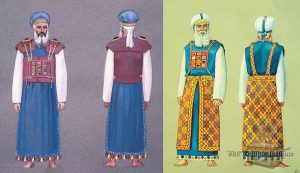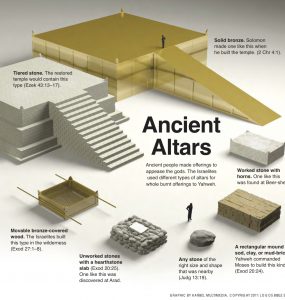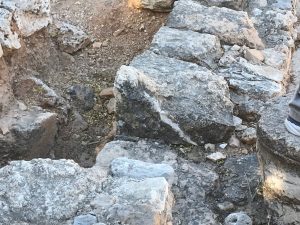THE GARMENT worn by the high priest represented the tribes of Israel, who were (symbolically) brought before the Lord when Aaron and his successors entered the Holy Place.
We discuss the ephod, probably a tunic or robe worn on the upper body, the breastpiece of judgment that held the twelve gemstones inscribed with the names of the tribes of Israel, and the purpose of the Urim and Thummim — about which we know very little even today.
We also discuss the altar, a wooden construction that allowed it to be moved from place to place, and compare it to the later stone structure at Shiloh and the permanent structure built by Solomon.
Here is the link to the Leen Ritmeyer article at Patterns of Evidence regarding the discovery of three blocked gates that may have led to underground music rooms on the Temple Mount.
JOIN US AND OUR SPECIAL GUEST CARL TEICHRIB IN ISRAEL! Our next tour of Israel is October 19–30, 2025. For more information and to reserve your place, log on to GilbertHouse.org/travel.
Our book Veneration is available for Amazon’s Kindle e-book reader! Click here and find out why readers rate Veneration 4.7 out of 5, describing it as “a must read” that “opens up…the Bible’s hidden mysteries.”
Click here for the complete archive of our New Testament Bible studies to date, click here for the Old Testament studies to date, and click here for our studies of the Book of 1 Enoch to date. Or go to www.spreaker.com/show/gilbert-house-fellowship for all of the audio.




When is the next redwing saga book coming out? I’ve been waiting since February. I received them all as a christmas gift last year and really enjoyed them.
Thank you for asking! Sharon is editing the book right now. It should be out in time for Christmas.
In the Brenton LXX, verse 26 says the Manifestation and the Truth on the Oracle of Judgment and it shall be on the breast of Aaron… I also just got the book ” The Tabernacle, Shadows of the Messiah” by David M. Levy. He says on Page 164 that the Urim means lights and was a beautiful picture of Christ, “light of life” and Thummim means perfections and speaks of the perfection of Christ. It looks like it is going to be an interesting book.
The 4 horns of the altar represented the north, south, west and east.
Stone altar: Abraham uses this when he sacrificed Isaac.
Brass (bronze) altar: where the flesh of the animals were sacrificed.
Golden altar: where incense is burned daily.
so…at the stone altar we learn obedience to God’s will; at the brass altar we discover freedom from sin and we discipline our flesh; at the golden altar we understand and practice daily prayer and worship.
The tunic or robe was open on both sides and worn directly against the skin. The material was knitted with a design of small squares that looked like jewels.
The ephod was a garment worn over the tunic. It was similar to an apron that covered the back and front, including the stomach, down to the hips. It was held with 2 shoulder straps. A strap tied the ephod in the front between the heart and waist. On top of the 2 shoulder straps were 2 large stones, carved with the names of the tribes, 6 on each stone, called remembrance stones as the priest was carrying the weight of God’s chosen people on his shoulders. The ephod also held the breastplate, which was held in place with gold chains and wooden cords.
A pomegranate was considered the holiest fruit in the temple. Tradition says that each mature pomegranate has 613 seeds, the same number 0f deeds and commandments a Jew must obey according to the Torah. The bells announced to God that the high priest was approaching His presence in the holy place.
On Yom Kippur, the Day of Atonement, Jewish sages believed that the 8 garments the high priest wore provided a picture of atonement for mankind: the tunic atoned for killing; the pants (breeches) atoned for sexual transgression; the turban (mitre) atoned for haughtiness; the belt atoned for sins of the heart; the breastplate atoned for errors in judgment; the ephod atoned for idolatry; the robe atoned for evil speech; the crown atoned for arrogance.